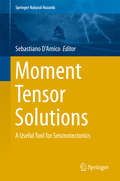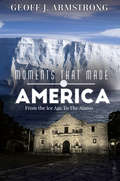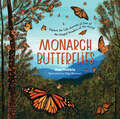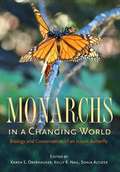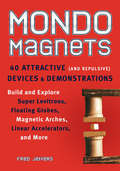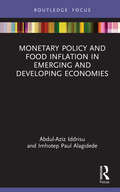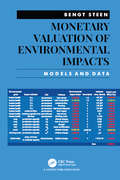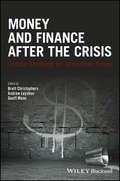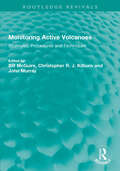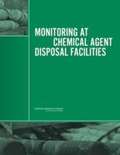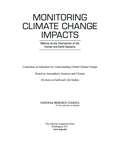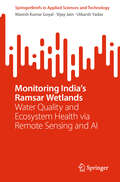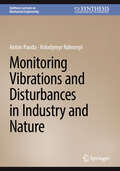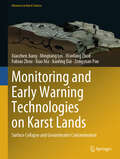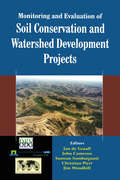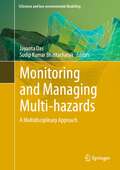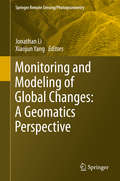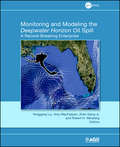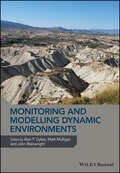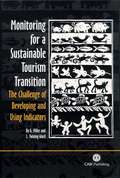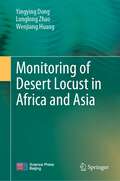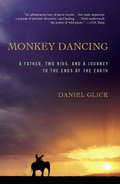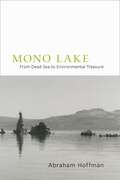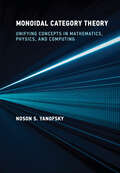- Table View
- List View
Moment Tensor Solutions: A Useful Tool For Seismotectonics (Springer Natural Hazards Ser.)
by Sebastiano D'AmicoThis book first focuses on the explanation of the theory about focal mechanisms and moment tensor solutions and their role in the modern seismology. The second part of the book compiles several state-of-the-art case studies in different seismotectonic settings of the planet.The assessment of seismic hazard and the reduction of losses due to future earthquakes is probably the most important contribution of seismology to society. In this regard, the understanding of reliable determination seismic source and of its uncertainty can play a key role in contributing to geodynamic investigation, seismic hazard assessment and earthquake studies. In the last two decades, the use of waveforms recorded at local-to-regional distances has increased considerably. Waveform modeling has been used also to estimate faulting parameters of small-to-moderate sized earthquakes.
Moments That Made America: From The Ice Age To The Alamo
by Geoff J. ArmstrongThere is something totally appropriate about the fact that North America, the continent that would someday contain the United States, was born in a cataclysm so violent, it ripped apart a gigantic super continent. A little more than two hundred million years ago, the continent we know as North America did not exist. From space, our planet looked nothing like earth of the 21st century. At that distant time in our planet’s history, all the continents that exist today were joined together into one giant landmass scientists call “Pangaea”. Then, on the 4th of July, 200,000,000 BCE (Before the Common Era) an immense earthquake hammered Pangaea. From the extreme northernmost point to the southern end, a deep fault in the earth split open and a huge chunk of Pangaea began to separate from the rest of the supercontinent. At first, the separation was only a few inches, but North America was born at that moment. A small piece of the scar from that cataclysm can be seen in a 20-mile line of cliffs called the Hudson River Palisades that run along the west side of the lower Hudson River near New York City.The date is highly imaginary of course. With no humans around to invent calendars, we can’t possibly know the exact date North America was born, but that date fits perfectly. This book focuses on all those incredible pivotal moments in all those thousands of years that followed that made North America and give the world the United States.
Monarch Butterflies: Explore the Life Journey of One of the Winged Wonders of the World
by Ann HobbieMonarch Butterflies is a richly illustrated, large-format book that celebrates North America&’s most recognized butterfly and educates children and families about what they can do to help protect these beloved pollinators from the impacts of habitat loss and climate change.
Monarch Butterfly (Live Oak Media Ereadalong Ser.)
by Gail GibbonsIntroduce young readers to the fascinating process of how catepillars become butterflies. Follow the transformation from a tiny white egg laid on a leaf to a brilliantly colored butterfly in this kid-friendly introduction to metamorphosis. With detailed, bright watercolors, Gail Gibbons illustrates the life cycle of the monarch butterfly, stage by stage, as it grows, changes, and takes flight. With clear, labeled diagrams and simple text that defines and reinforces important vocabulary, Monarch Butterfly introduces key concepts of insect anatomy and behavior. And of course, the unique migration of the monarch-- which can range up to four thousand miles-- is covered, with descriptions of how the insects travel, and how people in their path celebrate the occasion. This classic look at butterflies also includes directions on raising your own monarch at home, and a page of fun facts about these colorful butterflies.
Monarchs in a Changing World: Biology and Conservation of an Iconic Butterfly
by Kelly R. Nail Karen S. Oberhauser Sonia AltizerMonarch butterflies are among the most popular insect species in the world and are an icon for conservation groups and environmental education programs. Monarch caterpillars and adults are easily recognizable as welcome visitors to gardens in North America and beyond, and their spectacular migration in eastern North America (from breeding locations in Canada and the United States to overwintering sites in Mexico) has captured the imagination of the public.Monarch migration, behavior, and chemical ecology have been studied for decades. Yet many aspects of monarch biology have come to light in only the past few years. These aspects include questions regarding large-scale trends in monarch population sizes, monarch interactions with pathogens and insect predators, and monarch molecular genetics and large-scale evolution. A growing number of current research findings build on the observations of citizen scientists, who monitor monarch migration, reproduction, survival, and disease. Monarchs face new threats from humans as they navigate a changing landscape marked by deforestation, pesticides, genetically modified crops, and a changing climate, all of which place the future of monarchs and their amazing migration in peril. To meet the demand for a timely synthesis of monarch biology, conservation and outreach, Monarchs in a Changing World summarizes recent developments in scientific research, highlights challenges and responses to threats to monarch conservation, and showcases the many ways that monarchs are used in citizen science programs, outreach, and education. It examines issues pertaining to the eastern and western North American migratory populations, as well as to monarchs in South America, the Pacific and Caribbean Islands, and Europe. The target audience includes entomologists, population biologists, conservation policymakers, and K-12 teachers.
Mondo Magnets: 40 Attractive (and Repulsive) Devices and Demonstrations
by Fred JeffersSurprising and seemingly impossible effects result from the 40 experiments included in this fascinating science resource--all based on real magnetic physics. Each experiment--such as using a common refrigerator magnet to create a three-dimensional image or floating a magnet and carbon sheet in midair--is outlined with step-by-step instructions and diagrams that illustrate the key concepts of magnetism. Even the most experienced science teacher or at-home tinkerer will find dozens of new tricks in this amazing collection.
Monetary Policy and Food Inflation in Emerging and Developing Economies (Routledge Focus on Environment and Sustainability)
by Abdul-Aziz Iddrisu Imhotep Paul AlagidedeThis book focuses on the impact of monetary policy and food price volatility and inflation in emerging and developing economies. The tendency for food price volatility to blot inflation forecasting accuracy, engender tail dynamics in the overall inflation trajectory and derail economic welfare is well known in the literature. The ability of monetary policy to exact stability in food prices, theoretically, has also been well espoused. The empirical evidence, however, is not only in short supply, but also the studies available have dwelt on approaches that underplay the volatile behaviour of food prices. This book focuses on inflation targeting in emerging economies such as Chile, Mexico, Turkey, Brazil, Hungary, Russia, Colombia, South Africa, Indonesia and Ghana, as these are economies with considerable proportion of the consumption basket occupied by food. The book provides the means to understand at first hand the correct way to model food inflation, account for the related policy responses to deviations either in the short or medium to long term, and in market conditions that are subject to excessive variability. Strong evidence is presented that captures deviations of food prices from their trend and the accompanying monetary policy effect in stabilizing such variabilities across distinct frequencies. The novel approach in this book addresses the burgeoning puzzles of asymmetry in monetary policy effect on food prices at high, medium and low episodes of food inflation. In doing so, this book presents a powerful tool for researchers interested in understanding not just the transmission mechanism, but also the magnitudes involved, and to policymakers whose existing tools have failed them. Future studies will do well to deepen the evidence and seek new grounds to which the phenomenon manifests beyond and below emerging markets. This book will be of great interest to students, scholars and policymakers involved in agricultural economics, financial economics, food security and sustainable development.
Monetary Valuation of Environmental Impacts: Models and Data
by Bengt SteenThe book is meant to improve our understanding of sustainable development of production and consumption. Monetary values of the impact of emission and resources are determined, and used in environmental management, with a focus on sustainability. Values related to cultural context are not possible to predict, therefore ignored. The book only focuses on environmental goods and services that are used to satisfy basic human needs. One of the benefits of monetary valuation is its holistic approach. The impact of any contributing factor on the total value, can be determined, and the sensitivity to uncertainty in inputs can be estimated. This is useful in developing knowledge, where it is most needed. In a society, there are many economic units which need to function in tandem to support human welfare. Each unit has its own system boundary in what it includes and covers in time and space. The system boundary of a sustainable unit is likely to be very long and wide. This book provides data on long term monetary values of environmental impacts from human activities. It discusses the choice of system boundaries, and how to use monetary values in sustainable development. A large part of the book describes impact models in terms of the relation between emissions and natural goods and services.
Money and Finance After the Crisis: Critical Thinking for Uncertain Times (Antipode Book Series)
by Brett Christophers Geoff Mann Andrew LeyshonMoney and Finance After the Crisis provides a critical multi-disciplinary perspective on the post-crisis financial world in all its complexity, dynamism and unpredictability. Contributions illuminate the diversity of ways in which money and finance continue to shape global political economy and society. A multidisciplinary collection of essays that study the geographies of money and finance that have unfolded in the wake of the financial crisis Contributions discuss a wide range of contemporary social formations, including the complexities of modern debt-driven financial markets Chapters critically explore proliferating forms and spaces of financial power, from the realms of orthodox finance capital to biodiversity conservation Contributions demonstrate the centrality of money and finance to contemporary capitalism and its political and cultural economies
Monitoring Active Volcanoes: Strategies, Procedures and Techniques (Routledge Revivals)
by John Murray Bill McGuire Christopher R.J. Kilburn J. B. MurrayOriginally published in 1995, Monitoring Active Volcanoes is a comprehensive text which addresses the importance of volcano surveillance in the context of forecasting eruptive activity and mitigating its effects. The traditional core of seismic and ground deformation monitoring is discussed, along with more innovative techniques involving the recording of microgravity and micromagnetic variations, and the changing compositions of volcanic gases and liquids. The role of satellites is stressed, particularly with regard to the capabilities for measuring surface deformation, recognizing thermal anomalies and monitoring gas and ash plumes from space platforms. This book provides an invaluable insight into how and why volcanoes are monitored. It will be of interest to volcanologists, geophysicists and earth scientists.
Monitoring At Chemical Agent Disposal Facilities
by National Research Council of the National AcademiesUnder the direction of the U.S. Army’s Chemical Materials Agency (CMA) and mandated by Congress, the nation is destroying its chemical weapons stockpile. Over the past several years, the Army has requested several studies from the NRC to assist with the stockpile destruction. This study was requested to advise the CMA about the status of analytical instrumentation technology and systems suitable for monitoring airborne chemical warfare agents at chemical weapons disposal and storage facilities. The report presents an assessment of current monitoring systems used for airborne agent detection at CMA facilities and of the applicability and availability of innovative new technologies. It also provides a review of how new regulatory requirements would affect the CMA’s current agent monitoring procedures, and whether new measurement technologies are available and could be effectively incorporated into the CMA’s overall chemical agent monitoring strategies.
Monitoring Climate Change Impacts: Metrics at the Intersection of the Human and Earth Systems
by National Research Council of the National AcademiesThe stresses associated with climate change are expected to be felt keenly as human population grows to a projected 9 billion by the middle of this century, increasing the demand for resources and supporting infrastructure. Therefore, information to assess vulnerabilities to climate change is needed to support policies and investments designed to increase resilience in human and Earth systems. There are currently many observing systems that capture elements of how climate is changing, for example, direct measurements of atmospheric and ocean temperature. Although those measurements are essential for understanding the scale and nature of climate change, they do not necessarily provide information about the impacts of climate change on humans that are especially relevant for political and economic planning and decision making. Monitoring Climate Change Impacts tackles the challenge of developing an illustrative suite of indicators, measurements (and the locations around the globe where the measurements can be applied), and metrics that are important for understanding global climate change and providing insight into environmental sustainability. Eight panels provided input on: cryosphere, land-surface and terrestrial ecosystems, hydrology and water resources, atmosphere, human health and other dimensions, oceans (both physical and biological/chemical), and natural disasters. The book also provides an illustrative set of metrics that are likely to be affected by climate change over the next 20-25 years and, when taken together, can potentially give advance warning of climate-related changes to the human and environment systems.
Monitoring India’s Ramsar Wetlands: Water Quality and Ecosystem Health via Remote Sensing and AI (SpringerBriefs in Applied Sciences and Technology)
by Manish Kumar Goyal Vijay Jain Utkarsh YadavThis book offers a comprehensive overview of water quality assessment and wetland health monitoring in India's Ramsar sites using remote sensing and artificial intelligence. Featuring detailed methodologies and case studies from both coastal and inland wetlands, it highlights innovative technologies and strategies for monitoring, restoration, and sustainable management. With a focus on practical applications, the book emphasizes the role of policy, technology, and community engagement in wetland conservation, serving as a valuable resource for researchers, practitioners, and decision-makers involved in ecosystem protection.
Monitoring Vibrations and Disturbances in Industry and Nature (Synthesis Lectures on Mechanical Engineering)
by Anton Panda Volodymyr NahornyiA catastrophic phenomenon should not be considered a sudden and causeless event, but as a process whose characteristics are continuously changing throughout the entire previous period. This process manifests itself in the form of a trajectory of changes in time of the controlled parameter. This trajectory contains the information necessary for making decisions, both about the current degree of criticality of the system’s state and about the moment it reaches its limit state. This monograph discusses the method of searching for such a moment for a controlled system. The methodology consists of two complementary and therefore mutually validating forecasting methods. The first method analyzes the trend of a time series compiled from the results of monitoring the behavior of a controlled object, and the second method analyzes the periodic component, which together with the trend forms the original time series. The monograph considers the following processes as such processes: wear of the cutting tool, leading to defects in the workpiece; development of a manufacturing defect leading to an accident under operating conditions or catastrophe of products that differ in the volume of their production; preparation for earthquakes and volcanic eruptions.
Monitoring and Early Warning Technologies on Karst Lands: Surface Collapse and Groundwater Contamination (Advances in Karst Science)
by Wanfang Zhou Mingtang Lei Xiaozhen Jiang Jianling Dai Xiao Ma Fubiao Zhou Zongyuan PanThis book compiles a broad range of monitoring and early warning technologies focused on high-resolution in-situ water quality parameters at springs and monitoring wells. The surface collapses often cause severe damage to infrastructures, properties, and loss of lives, whereas contaminated groundwater poses risks to human health and the environment. Collapses are critical in karst systems, sparsing a seventh of Earth’s land surface. Karsts are also very relevant for drinking water, yet karst represents a fourth of global drinking water. Mitigating collapses and contaminated groundwater in karst aquifers can be complicated and costly. These parameters detect hydrodynamics, internal soil erosion, and ground deformation changes as karst collapse and pollution proxies. This book represents the most comprehensive overview of decades of research on karst collapse and groundwater contamination. This book is of interest to researchers and policymakers.
Monitoring and Evaluation of Soil Conservation and Watershed Development Projects
by Jan De Graaff John Cameron Samran Sombatpanit Christian Pieri Jim Woodhill Annemarieke De BruinThis book provides diverse information and critical know-how to implement appropriate methodology and cost-efficient monitoring and evaluation systems better suited to assess the impacts of soil conservation and wastershed multi-sectoral development activities. It draws on a worldwide experience of specialists and a large array of ground-truthing projects and programmes. This book will meet its objective if it contributes to convince financing institutions and project managers that integrated watershed management activities have the potential to generate highly desirable impacts for the society at large, which have to be accurately measured by adequate M&E systems.
Monitoring and Managing Multi-hazards: A Multidisciplinary Approach (GIScience and Geo-environmental Modelling)
by Jayanta Das Sudip Kumar BhattacharyaTo monitor multi-hazards, Remote Sensing and GIS-based multi-criteria decision-making (MCDM) techniques have been extensively used in recent years worldwide. Since natural hazards cannot be eliminated, only quantification of these events and reliable forecasting can alleviate their detrimental effects, through which we can build more resilient and safe societies. Moreover, cultivating the proper knowledge of the multi-hazards and their monitoring and management can fill the gap between science, policy, and the community concerned. In an endeavor to understand and characterize the various hazards, Monitoring and Managing Multi-hazards: A Multidisciplinary approach presents a synthesis of what cross-disciplinary researchers know about these hazards and indigenous adaptation strategies.The book therefore focuses on the use of precision techniques, Remote Sensing, and GIS technologies to quantify various natural, environmental and social hazards along with the capacity building and sustainable mitigation strategies towards resilient societies. It encompasses both thematic and regional case studies to highlight the dynamicity of climate change, change of natural resources, landscape, water, river, agricultural, and social ecosystems at various spatio-temporal scales, including theoretical and applied aspects. The book gives readers an overview and analysis of traditional and advanced geospatial technologies on atmospheric, lithospheric, hydrosphere, biospheric and socio-economic contexts, on all spatial and temporal scales regarding hazards and disasters and sustainable development and management for the future.
Monitoring and Modeling of Global Changes: A Geomatics Perspective
by Xiaojun Yang Jonathan LiThe chapters in this book present state-of-the-art geomatics technologies applied in global environmental studies. This text provides the latest research findings and delivers complete references to related publications. This book will motivate the undergraduate and graduate students, researchers and practitioners to better understand the environmental changes with informed solutions. Global Change studies are increasingly considered a vital source of information to understand the Earth Environment, especially in the framework of human-induced, climate change and land use transformation. Satellite Earth Observing systems and geomatics technologies provide a unique tool to monitor and model the changes, respectively. While the range of applications and innovative techniques are always increasing, this book provides a summary of key study cases where satellite data offers critical information to understand the usefulness of the geomatics technologies and global environmental issues. Geomatics technologies provide powerful tools to model and analyze the effects of those global environmental changes towards minimizing their adverse impacts on human health and the environment.
Monitoring and Modeling the Deepwater Horizon Oil Spill: A Record Breaking Enterprise, 1st Editio
by Yonggang Liu Amy Macfadyen Zhen-Gang Ji Robert H. WeisbergPublished by the American Geophysical Union as part of the Geophysical Monograph Series, Volume 195.Monitoring and Modeling the Deepwater Horizon Oil Spill: A Record-Breaking Enterprise presents an overview of some of the significant work that was conducted in immediate response to the oil spill in the Gulf of Mexico in 2010. It includes studies of in situ and remotely sensed observations and laboratory and numerical model studies on the four-dimensional oceanographic conditions in the gulf and their influence on the distribution and fate of the discharged oil. Highlights of the book include discussions of the following: immediate responses to the Deepwater Horizon oil spill using Integrated Ocean Observing System resources; monitoring the surface and subsurface oil using satellites, aircraft, vessels, and AUVs; mapping the oceanographic conditions using satellites, aircraft, vessels, drifters, and moorings; modeling the spreading of surface oil trajectories and the three-dimensional dispersal of subsurface hydrocarbon plumes; oil spill risk analyses and statistical studies on the fate of the oil; and laboratory investigation of ocean stratification related to subsurface plumes. This book will be of value to scientists interested in the Deepwater Horizon oil spill, the Gulf of Mexico, and the potential for conveyance of oil spilled in the Gulf of Mexico to the North Atlantic. A more technical audience may include those interested in oil spill detection, trajectory model forecasting, and risk analyses and those with an interest in applied oceanography, including scientists, engineers, environmentalists, natural and living marine resource managers and students within academic institutions, agencies, and industries who are involved with the Gulf of Mexico and other regions with offshore oil and gas exploration and production.
Monitoring and Modelling Dynamic Environments
by John Wainwright Mark Mulligan Alan P. DykesThe Times (Obituaries, 4 August 2008) reported that "John Thornes was one of the most eminent and influential physical geographers of his generation." John's keen interest in understanding landform processes and evolution was furthered through a variety of methods and informed across a range of disciplinary boundaries. In particular he pushed for better integration of monitoring, theoretical and simulation modelling, field and laboratory experimentation and remote sensing techniques. Although dominated by an interest in the Mediterranean region and problems of land degradation, his research activities ranged across a number of time scales and with other environmental perspectives. This collection of papers reflects this wide range of John's interests through the recent work of scientists and professionals most strongly influenced by his rigorous training or leadership. The thematic focus of the book, which runs through all of the main contributions, is the integration of different methodologies and the application of this approach to improved understanding of natural systems and the development of appropriate strategies for environmental and resource management. Short overviews of John's contributions to geomorphological research are also presented to provide context for the origins of this book.
Monitoring for a Sustainable Tourism Transition: The Challenge of Developing and Using Indicators
by Graham Miller Louise Twining-WardSustainable tourism is not a static target, but a dynamic process of change, a transition. This book considers how monitoring using indicators can assist tourism to make such a sustainability transition. It encourages the reader to view tourism from a broad, interdisciplinary perspective and draws on material from a wide range of sources. The book explains why monitoring is important for different groups of stakeholders; public and private sector, NGOs and communities. It also examines important monitoring considerations such as what and where to measure, how much will monitoring cost and how the data can be presented. The book puts particular emphasis on indicator use and implementation. It highlights the process and techniques to develop and use indicators and then provides clear and detailed examples of monitoring in practice around the globe at different geographic scales.
Monitoring of Desert Locust in Africa and Asia
by Yingying Dong Longlong Zhao Wenjiang HuangThis book deals with the topic on remote sensing monitoring of desert locust in Africa and Asia. Remote sensing monitoring of the occurrence and damage of desert locust is conducted by integrating cutting-edge technologies and methods in cross-disciplinary fields in remote sensing science, geographic information science, agronomy, plant protection, agricultural meteorology, mathematics, and computer science. The main contents include spatio-temporal data analysis and processing, desert locust breeding areas monitoring, pest migration path analysis and damage monitoring. Moreover, a desert locust remote sensing monitoring system is constructed and applied in the region of Africa and Asia countries. This book not only provides technical reference for remote sensing monitoring and application of desert locust but also serves as a research reference for scholars and graduate students engaged in agricultural remote sensing, agricultural information technology, plant protection and other related field. It will help to improve remote sensing monitoring and application of desert locust.
Monkey Dancing: A Father, Two Kids, And A Journey To The Ends Of The Earth
by Daniel GlickAn inspiring globe-trotting road trip with a personal and environmental agenda. . . definitely an armchair trip worth taking. "?Seattle Post-Intelligencer"
Mono Lake: From Dead Sea to Environmental Treasure
by Abraham HoffmanMono Lake is one of the largest lakes in California, and Californians have been using it, enjoying it, and abusing it since nomadic northern Paiutes began hunting the lake&’s vast bird populations. Controversy between environmentalists and the City of Los Angeles brought so much attention to Mono Lake in the late twentieth century that it became best known for its appearance on &“Save Mono Lake&” bumper stickers. This thoughtful study is the first book to explore the lake&’s environmental and cultural history.Hoffman writes about gold mining in the Mono Basin; the taking of birds and their eggs to supply food for miners and townspeople; a failed oil boom; efforts to develop recreational activities such as a state-operated marina, which also failed; catastrophes including plane crashes and the testing of bombs underwater; and litigation over the diversion of creeks flowing into the lake and the resulting decline in the lake level. A variety of photographs, some never before published, ranging from mining to motor boat races in the 1930s are also included.
Monoidal Category Theory: Unifying Concepts in Mathematics, Physics, and Computing
by Noson S. YanofskyA comprehensive, cutting-edge, and highly readable textbook that makes category theory and monoidal category theory accessible to students across the sciences.Category theory is a powerful framework that began in mathematics but has since expanded to encompass several areas of computing and science, with broad applications in many fields. In this comprehensive text, Noson Yanofsky makes category theory accessible to those without a background in advanced mathematics. Monoidal Category Theorydemonstrates the expansive uses of categories, and in particular monoidal categories, throughout the sciences. The textbook starts from the basics of category theory and progresses to cutting edge research. Each idea is defined in simple terms and then brought alive by many real-world examples before progressing to theorems and uncomplicated proofs. Richly guided exercises ground readers in concrete computation and application. The result is a highly readable and engaging textbook that will open the world of category theory to many. Makes category theory accessible to non-math majorsUses easy-to-understand language and emphasizes diagrams over equationsIncremental, iterative approach eases students into advanced conceptsA series of embedded mini-courses cover such popular topics as quantum computing, categorical logic, self-referential paradoxes, databases and scheduling, and knot theoryExtensive exercises and examples demonstrate the broad range of applications of categorical structures Modular structure allows instructors to fit text to the needs of different courses Instructor resources include slides
